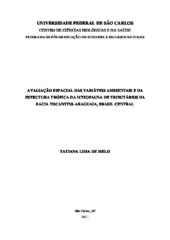| dc.contributor.author | Melo, Tatiana Lima de | |
| dc.date.accessioned | 2016-06-02T19:29:35Z | |
| dc.date.available | 2011-10-06 | |
| dc.date.available | 2016-06-02T19:29:35Z | |
| dc.date.issued | 2011-05-10 | |
| dc.identifier.citation | MELO, Tatiana Lima de. Avaliação espacial das variáveis ambientais e da estrutura trófica da ictiofauna de tributários da Bacia Tocantins Araguaia, Brasil Central. 2011. 85 f. Tese (Doutorado em Ciências Biológicas) - Universidade Federal de São Carlos, São Carlos, 2011. | por |
| dc.identifier.uri | https://repositorio.ufscar.br/handle/ufscar/1717 | |
| dc.description.abstract | This study aimed to compare the ichthyofauna and characterize the physical environmental variables and trophic structure of fishes in tributaries of the Tocantins- Araguaia, state of Goias. The samples were collected in 54 streams and rivers, 28 tributaries of Araguaia River and 26 of Tocantins River. For comparison of the ichthyofauna was used CPUE biomass and for the characterization of the variables were considered the altitude, channel width, luminosity, channel depth, turbidity, water velocity and organic detritus. The trophic structure was determined based on the diet of the fish fauna through analysis of stomach contents and data from literature. The results showed that the biomass of fish fauna present difference between the basins and rivers and streams collected. The analysis showed that the highest values of turbidity and water velocity were more significant for rivers, while in the streams the velocity, luminosity and width were more important. The trophic structure of fish fauna of rivers and streams of the Tocantins-Araguaia was represented by eight trophic guilds (algivore, carnivore, detritivore, herbivore, invertivore lepidophage, omnivore and piscivore), being composed mainly omnivores, invertivores, piscivores and detritivores species of the fishes. The heterogeneity of habitat found in sites sampled may be the main factor for the differences between the rivers and streams studied. For some of the stretches sampled in the basin of Araguaia River are inserted in a flood plain, while those of the Tocantins River basin draining mountainous areas. | eng |
| dc.description.sponsorship | Universidade Federal de Sao Carlos | |
| dc.format | application/pdf | por |
| dc.language | por | por |
| dc.publisher | Universidade Federal de São Carlos | por |
| dc.rights | Acesso Aberto | por |
| dc.subject | Ictiologia | por |
| dc.subject | Rios e riachos | por |
| dc.subject | Guildas tróficas | por |
| dc.subject | Peixes neotropicais | por |
| dc.subject | Neotropical fishes | eng |
| dc.subject | Icthiobiomass | eng |
| dc.subject | Water velocity | eng |
| dc.title | Avaliação espacial das variáveis ambientais e da estrutura trófica da ictiofauna de tributários da Bacia Tocantins Araguaia, Brasil Central | por |
| dc.type | Tese | por |
| dc.contributor.advisor1 | Peret, Alberto Carvalho | |
| dc.contributor.advisor1Lattes | http://genos.cnpq.br:12010/dwlattes/owa/prc_imp_cv_int?f_cod=K4787085A9 | por |
| dc.description.resumo | Este estudo tem como objetivo comparar a ictiofauna e caracterizar as variáveis físicas ambientais e a estrutura trófica da ictiofauna em tributários da bacia Tocantins- Araguaia, estado de Goiás. As coletas foram realizadas em 54 rios e riachos, sendo 28 tributários da bacia do rio Araguaia e 26 do rio Tocantins. Para a comparação da ictiofauna foi utilizada a CPUE da biomassa e para a caracterização das variáveis foram consideradas a altitude, a largura, a luminosidade, a profundidade, a turbidez, a velocidade da água e o detrito orgânico. A estrutura trófica foi determinada com base no hábito alimentar da ictiofauna através de análise de conteúdo estomacal e dados da literatura. Os resultados mostraram que a biomassa da ictiofauna apresenta diferença entre as bacias e rios e riachos coletados. As análises mostraram que os maiores valores de turbidez e velocidade da água foram mais significativos para os rios, enquanto que nos riachos a velocidade, a luminosidade e a largura foram mais importantes. A estrutura trófica da ictiofauna dos rios e riachos da bacia Tocantins-Araguaia foi representada por oito guildas tróficas (algívora, carnívora, detritívora, herbívora, invertívora, lepidófaga, onívora e piscívora), sendo composta principalmente por espécies onívoras, invertívoras, piscívoras e detritívoras. A heterogeneidade do habitat encontrada nos trechos amostrados pode ser o principal fator para as diferenças encontradas entre os rios e riachos estudados. Pois alguns dos trechos amostrados na bacia do rio Araguaia se encontram inseridos em uma planície inundável, enquanto que estes da bacia do rio Tocantins drenam áreas montanhosas. | por |
| dc.publisher.country | BR | por |
| dc.publisher.initials | UFSCar | por |
| dc.publisher.program | Programa de Pós-Graduação em Ecologia e Recursos Naturais - PPGERN | por |
| dc.subject.cnpq | CIENCIAS BIOLOGICAS::ECOLOGIA | por |
| dc.contributor.authorlattes | http://lattes.cnpq.br/5554075100354026 | por |
